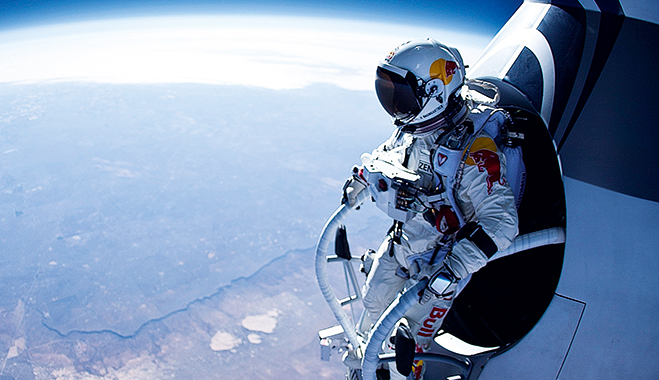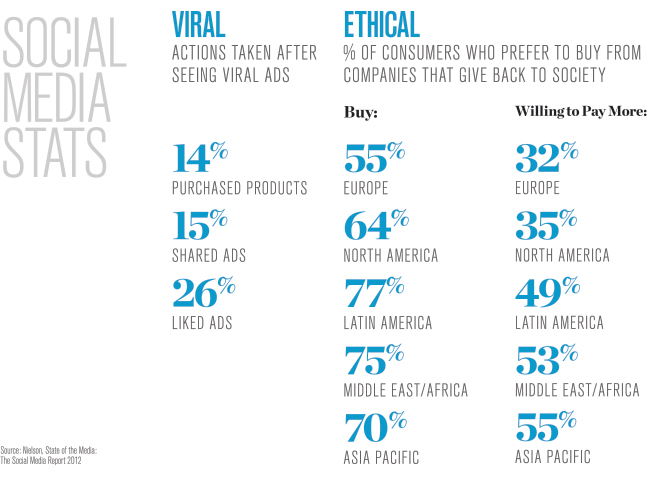
From the edge of space, Felix Baumgartner plummeted to earth, falling from an altitude of 39km to become the first person to break the speed of sound unaided. This remarkable achievement by the 43-year-old adventurer not only pushed the limits of science, technology, and human endeavour, it set a new frontier in marketing. Red Bull, the energy drink producer, had pulled off what was arguably the most audacious and expensive PR stunt in memory with its sponsorship of the Stratos mission. Eight million people tuned in online to watch the “mission to the edge of space”, while countless others watched on television news channels worldwide as a man in a spacesuit – prominently brandishing the Red Bull logo – made history. The stunt enjoyed global coverage, positioning the Red Bull brand as audacious, bold, intelligent and extreme, targeting and appealing to those keen to push the boundaries. In more than one sense, Red Bull Stratos was a huge success.
Marketing has come a long way from the heyday of the radio jingle and the flashy sales poster. More and more extravagant brand fermentation enterprises, such as the Stratos project, are helping companies expand and penetrate new and unsaturated markets. Marketers are able to aim for a wider audience as the power of the internet allows a brand to gain exposure across the globe quickly and cost-effectively. Equally as useful, the amount of information available on buyers has mushroomed in recent years, allowing targeted and informed selling to the most attractive markets.
Various new strategies and techniques are shaking up the promotional mix – the combination of advertising, sales promotion, personal selling, direct marketing and PR – as companies aim to grab market share from their rivals. As methods of delivery become more extravagant and tailored, the market for promotional activities becomes unrecognisable, and the traditional set of marketing tools almost redundant.
Going viral
Advertising traditionally focuses on promoting a brand by informing consumers of the benefits it provides, within a context the reader or viewer can relate to. Marketers traditionally rely on quality copywriting, enticing slogans and memorable characters to try to convince potential buyers that a product will make their lives more enjoyable, exciting or easier. From Apple’s famous Nineteen Eighty-Four-esqe commercial, to the slogan “Guinness is good for you”, advertisers competed to create more attractive and convincing ads for the billboards, magazines and television sets of the world.
Businesses today still spend a hefty chunk of their marketing budgets putting out advertising, but the nature of these ads has evolved. Advertisers are increasingly focusing on making their messages personally relevant to consumers in specific markets and creating “demand by association”. Unilever brand Lynx capitalised on the leaking of controversial photographs of Prince Harry at a Las Vegas party, when it ran an ad with the caption, “Sorry Harry, if it had anything to do with us”. The technique, known as ‘news jacking’, positions the brand with the story of the day. Advertisers have always employed similar techniques, for example aligning the brand with macro socio-economic trends, such as Nike’s “Just do it” campaign, which jumped aboard the late 20th century’s growing middle-class interest in recreational sports, or aligning with more personal issues, such as Suzuki’s “A range that’s never out of yours” campaign, which highlighted the buyer’s many needs during a time of economic insecurity.
Traditionally, advertisers placed campaigns in media that wouldn’t just appeal to their target audience, but could also help position the brand. For instance, Pizza Hut’s successful Super Bowl TV adverts and Calvin Klein’s print ad in Men’s Health. Product placement, however, has let advertisers enjoy more of that pre-established, third-party brand. In the latest James Bond blockbuster Skyfall, the world-famous spy and sex symbol sips on a Heineken, neither shaken nor stirred. While strategic placement of merchandise in film or television is certainly not a new phenomenon (the 1927 film Wings – the first to win an Academy Award for Best Picture – contained a plug for Hershey’s chocolate), the idea has seen a surge in popularity lately. Skyfall alone took in an estimated $45m in product placement. Neither is it enough for products to simply appear in film, languishing in the background and largely removed from the plot: they are actively utilised in what is known as ‘brand integration’. In Skyfall, MI6’s gadget man – Q – uses the latest technology to foil a plot created by the world‘s most unpredictable super villian.
Essentially, the bad guys would win if it weren’t for Sony’s Vaio laptop, never too far from Q’s – and the audience’s – line of sight.
Successful global advertising need not require huge sums of money. With the internet and the phenomenon of viral videos, companies can market their product around the globe for relatively little cost. They produce a creative, controversial, funny or otherwise attention-grabbing video promoting a product or service that the consumer will hopefully proceed to pass on to others. DollarShaveClub.com, a US start-up, achieved almost instantaneous global brand awareness through a 90-second video featuring its CEO and a few other employees in the company’s warehouse. This kind of advertising has the dual advantage of getting the message out to a wide audience and being targeted, since internet users who like the ad are likely to share it with others who have similar tastes.
The golden ticket
Traditional methods of sales promotion typically involve coupons, rebates, temporary discount offers or trade-ins that are designed to increase the likelihood of product purchase. Companies have often preferred to use classical advertising mediums such as billboards, television commercials, street flyers or clip-out coupons in magazines to get their offers across to the consumer. While these campaigns do bring in extra customers and can be relatively well targeted, they don’t always provide the best rate of return.

A new option has arisen in the form of websites such as Groupon or LivingSocial, which broker an amalgamation of time-restricted offers, appealing to consumers primarily shopping for sales. The brokers help reduce costs for businesses and increase response rates. Because of the sale appeal, consumers sign up for email notification, essentially turning their inbox into a personalised billboard, that they themselves have signed up for, instead of generic phishing – or so it would seem.
Another growing promotional technique being utilised by companies, especially within the retail sector, is the use of loyalty cards. Customers are offered incentives – such as price reductions or points-collecting programmes – to sign up for the scheme, which make them more likely to continue purchasing products from the same retailer in the future. In the process, the consumer provides personal information to the company and, with advanced Electronic Point of Sales technology, businesses can record the type of products purchased when the card is used. This information can then be used to create future sales promotion strategies.
Participants may also receive advanced notice of deals in relation to other consumers, creating a sense of excitement and exclusivity beneficial to the retailer. Tesco, the multinational supermarket chain, uses its ClubCard to inform its order management system and buying habits. The feedback also contains demographic information so the
firm knows who is shopping in each store and what type of offers will be successful in
different geographies.
Personal selling
Face-to-face communication and direct interaction between salesperson and client has helped many companies facilitate sales for decades. Door-to-door selling, telemarketing and the party plan – where potential consumers and resellers are invited to an event showcasing the product by the salesperson – have been effective methods to sell products, where a personal pitch and specialised knowledge is vital. In business-to-business markets, personal selling is likely to continue to be a necessary and costly evil, as goods and services are often complicated and involve large sums of money changing hands. In consumer markets, companies such as cosmetics retailer Avon has strategically targeted affluent neighbourhoods in order to better focus distribution and sell to geographically positioned experts. Advances in information technology and greater globalisation have provided new opportunities to personal sellers and created more discerning customers.
It is not simply about sponsoring an event anymore, it has become about ownership and creation
The modern consumer is more likely to be informed about product alternatives, meaning personal sellers must be highly capable, informed and provide a strong and appealing face for the product or service. Companies can also scope out potential clients better than ever before with the wide availability of consumer data on the internet. Cold calls and sales pitches have become increasingly targeted as this data reduces random calling or door knocking.
The Facebook’s ‘like’ and Google’s +1 functions have helped reveal important personal consumption habits, which assist in identifying potential clients to contact with product offers. Online company sales personnel can also join relevant groups or circles which are likely to have an interest in their products.
Businesses can use various web tools such as Google Analytics to scope out which segments of the market to target by researching web traffic. They can find out which age group, gender or geographical area would be more likely to purchase a product. YouTube’s video statistics provide similar information about video watching.
For a more direct approach, Twitter offers businesses potential benefits via its own search function. Sellers can search for tweets about the product they are offering, narrowing down the results by geographical area and time frame. This information can then be used to contact the person with information about the company’s merchandise or to offer them an enticing discount. For instance, if someone in Berlin tweets that he’s thinking of buying a computer, a local distributor from the area can send him a personal message selling their product.

Like if you hate spam
In the past, companies would send out mass letters, emails, text messages or phone calls in the hopes of hitting a significant number of interested buyers. The direct marketing strategy allowed them to communicate directly with potential customers about the benefits of their product. Around the turn of the century, as email grew to become the principal source of communication, readers soon became weary of the vast amount of unsolicited spamming, and email marketing took a hit by proxy.
To avoid this problem, businesses are increasingly likely to try to directly connect with specific potential clients through trusted brands, such as those built by social networking sites, in which the target audience has already a vested interest. Many – such as eBay on Facebook – have their own pages on a variety of social networking sites where they communicate with the public, offering information about new merchandise, sales or special offers directly to an audience that has already registered an interest in the brand.
Websites like Facebook allow advertisers to better target their online ads by matching them with personal information provided by their users. Market research from Nielson shows 14 percent of users purchased a product after viewing an ad on social networks, 15 percent shared it with other users and 26 percent liked it.
Another strategy is to get consumers involved in the actual marketing of products with interactive online campaigns. For example, in a marketing campaign for Juicy Juice, Nestlé asked Twitter users a series of questions, such as, “How important is vitamin-enhanced food to you?”, and then had the answers posted in online ads. This helped involve potential customers in the marketing process and foster engagement with the brand. Volkswagen hid tickets to a Brazilian music festival it had sponsored and provided an online map to users. The map progressively zoomed in on the location of the tickets as an increasing number of people tweeted the designated hashtag. The real world treasure hunt was an instant success as the topic trended in Brazil and helped increase Volkswagen’s exposure to the local market.
More than wings
Companies are finding new and bolder ways to promote themselves and build brand equity: the value of having a well-known and liked brand name. It is not simply about sponsoring an event anymore, it has become about ownership and creation. A buyer 20 years ago would have been happy to see a brand on the side of a sports car – like Marlboro’s sponsorship of the McLaren F1 team. Now, though, there’s a lot more flexibility when marketing. Red Bull’s Stratos stunt is just one in a whole series of new-age PR events the energy drinks giant has used to enhance awareness of its products.
The Red Bull Air Race – where pilots zip through an obstacle course in small planes – and Red Bull Crashed Ice – a downhill skating event on an icy track – are two such examples. These extreme sports events, along with the company’s ownership of more traditional teams, such as football and F1 racing, help to promote the brand as part of an active and exciting lifestyle to a wide audience: thanks in large part to media coverage and social networks. The key is Red Bull is involved in every aspect of its promotions. It doesn’t pay to put its brand logo on an F1 car or football kit, it owns the team and is active in ensuring its success to generate positive publicity.
Positive publicity can also be gained from taking an active part in social causes, both at the global and local level. This can happen by participating in a variety of endeavours to raise a company’s profile, such as charity, environmental consciousness and fair trade. Research from Nielson shows 55 percent of European consumers prefer to buy from companies which give back to society and 32 percent are even willing to pay extra for the product or service of a socially conscious company. These figures are even higher in other parts of the world.
Starbucks is keen on showing it is one such company, with social commitment being an important part of its overall marketing strategy. The coffee giant has initiatives aimed at making all paper cups recyclable by 2015, designing ‘greener’ stores, following specified fair trade practices when purchasing coffee and helping support local farmers with loan programmes. While these plans are global in ambition, large companies can also be active at the local level. McDonald’s stores in the UK often hire street cleaners to help keep the neighbourhood free of litter. These cleaners, their clothing brandishing the company logo, help generate positive publicity by showing that a global business can still take an active and constructive role in the local community.
In an increasingly interconnected world, PR strategies have been used to great effect to increase a brand’s reputation and exposure to a variety of markets. On the other hand, PR disasters – such as the BP Deepwater Horizon oil spill – are more likely than ever before to significantly harm a company as word spreads quickly across the globe. Company PR departments must be ready to deal with the challenge of unexpected negative publicity to restore brand equity and trust between business and consumer. A good PR department can help mitigate the damage as well as promote the brand. In today’s increasingly globalised world, its portion of the promotional mix may be of the greatest importance.

